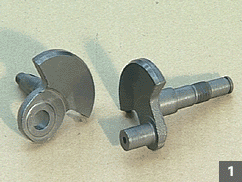 |
 |
 |
| Machining stages of the crankshaft |
 |
   |
|
 |
Crankshaft assembly.
Before assembly of the crankshaft the stroke pin is ground and, on the mating piece, the stroke-pin hole is hard turned. Then the shaft can be assembled with the connecting rod and bearing over the stroke pin.
After assembly the journals are machined in one chucking. As a result the crankpins are centered to one another, ensuring little vibration and extreme durability.
|